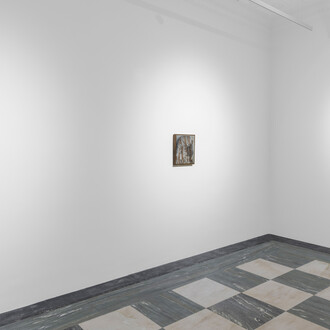As much as genre does to sort, classify, and package form, content, and style, its uses slyly evade a straightforward understanding of what strictly constitutes pictorial meaning.
Western art historiography informs much of our judgment of genre in the visual realm — particularly in painting, as the discipline rose to exalted status in seventeenth-century French academic circles. By the mid-nineteenth century, the nationalized institutions that dictated the painting’s hierarchy of genres began to lose aesthetic authority, and classical pedagogy was troubled by the increasing industrialization and modernization that swept Europe. And yet, we are still left with the traces of this didactic and widely expatiated order that helps us register the pictorial image.
Though at points it has maintained inconsistent standards of value and importance, genre has perhaps always been a flexible framework of limits. Even with the pervasion of abstraction in the twentieth century, a time of great global upheaval, the need to categorize and organize compositions found other indices, primarily vis-à-vis the grid. If there is no conclusion or explanation that would satisfy our understanding of genre, which existed before the establishment of any such Académie des beaux-arts, it can be possibly considered a drive—accommodating, among other wants, an innate desire to taxonomize, understand how stories can be told, or visually capture and perceive a moment or sensibility.
This group exhibition presents works on paper from the past century that variously engage with genre. By both adhering to and turning away from this seemingly arbitrary classification system, this selection of both preparatory and finished works considers the uses and desires of genre and, ultimately, genre’s expansiveness and mutability.
Operating within and outside of its support, the affective dimension of a work of art reveals the negotiation of power that traffics between the image and viewer as well as between the image and the wider world. In Portrait of a Dark Haired Woman (1943), Alice Neel (1900–1984) shows the subject from the waist up, leaning slightly back, her hand cupping her chin. An untitled work on paper by Cy Twombly (1928–2011) features a face with a prominent nose and a downcast, squinting eye that peers out of the frame. Tishan Hsu’s (b. 1951) pencil study lays a heavy scribble of fleshy pink over pairs of blue and green eyes. Mostly suggestive and unfixed in their depictions, these works exemplify how portraiture has performed in perpetuity, enveloping the spectrum between memorialization, discovery, and concealment.
In the academy, history painting was the paradigmatic genre, and the allegories that artists produced were often in the service of monarchist propaganda. Here, though less overtly moralistic or political in tone, compositions by multiple generations of artists show the means by which they set the process of signification into motion. Playfully renewing the meta qualities of academic exercises, Philip Guston’s (1913–1980) ...Smoking and Drawing (1972–75) allegorizes the titular subjects and inscribes below them a line by the poet and musician Clark Coolidge, with whom the painter collaborated. In a work by Robert Colescott (1925–2009), a reddish head crowned with the words “Nile Queen” peeks like a sunrise above a valley of cartoon characters awash in brown pigment. Colescott appropriates the ubiquitous motifs of pop culture to subtly satirize myths of innocence. Nancy Spero’s (1926–2009) fierce antiwar stance is foregrounded in F111 - Victims in River of Blood (1967), encompassing her direct critique. Shattered limbs burst across the surface, which is clouded in smears of brown pigment that imitate the bodily fluid.
Violence’s counterpart, sex, and humor likewise vibrate throughout images that seem motionless at first glance, accommodating overlaps and alternating between genres and intentions. Study for Silent Mist (2022) by Craig Boagey (b. 1985) vacillates between still life and pornographic money shot, the mushroom’s wet cap oozing cloudy fluid amid a grassy landscape. Tracey Emin’s (b. 1963) work on paper Fuck Me (2020) pictures a pair of blue spread-eagled legs in quick, sure brushstrokes; the composition evokes Gustave Courbet’s 1866 painting L’Origine du Monde while its title explicitly demands pleasure. In Paul Thek’s (1933–1988) Some Drawings of Pussies (1980), the artist highlights the ornamental nature of body parts and gathers a group of montes pubis into a loose grid on a lined page.
Artists have long explored the grid’s sweeping capacities and abilities to index the spatial and temporal. Depicting both a face in profile and a human figure, Eden (2016) by Isabella Ducrot (b. 1931) wavers between genre scene and landscape, all the while incorporating an enigmatic floating grid in the center of its composition. Olivia van Kuiken (b. 1997) fills out the grid with vibrantly colored squares in an untitled drawing from 2022, overlaying a tangled mass of scribbled lines that adds tension to the surface of the composition. Recasting its seemingly rigid format, a work by Richard Prince (b. 1949) roughly scrawls a series of jokes on a three-by-three rectangle. Stanley Whitney’s (b. 1946) black-and-white drawing assumes the painter’s favored patchwork grid, which references the likes of classical art and architecture as well as the improvisatory structures of jazz. Bracketed by both the year the work was made—“2020”—and the inscription at the bottom—“always running from police”—Whitney’s grid takes into account the uprisings of that time as well as others and impresses into his composition the continuing reality of the brutality of the carceral state.
(Text by Hyunjee Nicole Kim)
















